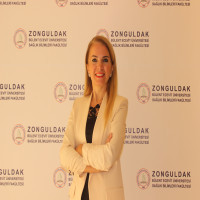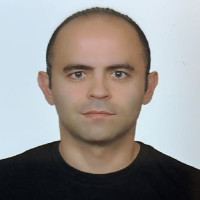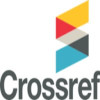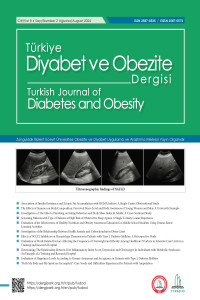Research Article
Clinical Research
Aim & Scope
The aim of the journal is to announce quality researches in obesity
and diabetes mellitus and respective subjects to the national and
international scientific environment, sharing and creating a continuous
training platform to contribute to the provision of scientific and social
communication in Turkey and abroad
In pursuit of these objectives in the journal original research, case
reports, reviews, letters to the editor, biography, writings and conference
proceedings brought to articles format are published. The papers presented
at the symposium, congress, electronic media or preliminary studies can
be published provided that this is stated
Author Guidelines
Cover Page
The Turkish and English title of the article, and the names and surnames of the authors are provided. Authors from the same institution are written by numbering the names and addresses of the clinic, department, institute or organization in the order of the authors in order to receive the same number. The short title of the article should also be given. The name of the author to whom correspondence will be made, full mailing address, telephone, fax number and e-mail addresses should be written. If the study was presented as a paper at a congress or a conference, the authors should indicate this at the end of the page, giving the name, place and date of the congress/conference or the institution receiving support and the project number.
Abstract
The abstract, not exceeding 250 words, needs to be written in Turkish and English. It should include introduction, materials and methods, findings and conclusion sections. Abbreviations and references should not be used. Turkish keywords provided at the end of the abstract should be between three and seven words and given in alphabetical order in accordance with the Index Medicus Medical Titles (MeSH) list. An English abstract should be written on another page, with a one-to-one translation of the Turkish abstract and keywords. In case reports, there should be a structured abstract that includes objective, case(s), and conclusion(s).
Main Text
The main text of the article should be given under the headings of introduction, materials and methods, findings and discussion. All measurements must be given in the metric system. Symbols and abbreviations must comply with international standards. Abbreviations should be explained when first seen in the text and should be limited to those that are generally accepted. Tests used for statistical analysis should be stated in the text and tables. Authors can state, under the acknowledgment heading at the end of the text, any individuals, institutions and organizations that contributed to the realization of the study. Conflict of interest, author contribution declaration, financial support and ethics committee approval headings must be filled in at the end of the article.
Tables, Figures and Images
Tables should come after the references in the main text and each table should be on a separate page and double-spaced. It should be numbered according to the order of occurrence in the article and contain a short caption. Their locations should also be specified in the text. The table caption should be at the top of the table, and table descriptions and abbreviations should be at the bottom.
Images and figures must be uploaded to the system in “.jpeg” or “.tiff” format with a pixel size of at least 800x600 and a resolution of 1000 dpi. Magnification and staining techniques should be indicated in histological section and cytology photographs. Image and figure captions should be given on a separate page at the end of the article. Figure captions should be short and descriptive. Figures that appear together in the same column may have the same number with different letters (such as 1A, 1B). If possible, a scale should be added to the photograph.
References
References should be numbered in the order of their appearance in the article, their numbers should be stated in parentheses at the end of the sentence in the text, and they should be shown in the reference list according to the number they appear in the text. The source list should be on a separate page. In the reference list “et al.” (et al.) abbreviation should not be used, all authors should be included.
Jounal Article
Author name(s), title of the article, journal name (must be abbreviated according to the list given in “lndexMedicus”), year, volume number, first and last page number.
Ergenç M, Özaçmak Sayan H, Turan İ, Özaçmak VH. Effect of spironolactone on glycogen and oxidative stress parameters in prefrontal cortex and eye tissues in rats in which surgical menopause and chronic cerebral hypoperfusion performed. Med J West Black Sea. 2022;6(2):177-185.
Book:
Name(s) of the authors of the chapter, title of the book, edition, place of publication, publisher, year.
Larsen PR, Kronenberg HM, Melmed S, Polonsky KS. Williams Textbook of Endocrinology, 10th Edition, Philadelphia, Elsevier Science, 2003.
Book Chapter:
Author name(s) for the chapter, chapter title, editor(s), title of the book, place of publication, publisher, year, first and last page numbers.
Klein S, Romijn JA. Obesity. In: Larsen PR, Kronenberg HM, Melmed S, Polonsky KS. Williams Textbook of Endocrinology, 10th Edition, Philadelphia,Elsevier Science, 2003, p.1642-1706.
Online articles:
Abood S. Quality improvement initiative in nursing homes: the ANA acts in an advisory role. Am J Nurs [Internet publication]. 2002;102(6). (Accessed Date: 12.08.2002 http://www.nursingworld.org/AJN/2002/june/ Wawatch.htm)
Thesis:
Sağlam C. Effect of glp-1 agonist on depression-like behaviors in young female rats created as a surgical menopause model. (Master’s Thesis), Zonguldak, Zonguldak Bülent Ecevit University, 2022, 1-106 (Access Link and Date: ).
Ethical Principles and Publication Policy
Ethical Rules
Zonguldak Bulent Ecevit University, Obesity and Diabetes Practice and Research Center’s publication of the peer-reviewed the "Journal of Turkish Journal of Diabetes and Obesity" aims to achieve free to all institutions and individuals is a national and international journals.
In the scientific articles sent to our journal, the recommendations of the ICMJE (International Committee of Medical Journal Editors) and the International Standards of COPE (Committee on Publication Ethics) for Editors and Authors are taken into consideration.
Ethical Rules for Peer Reviewers
• Reviewers respect the confidentiality of the articles they evaluate and donot discuss the article or communicate with anyone else about the article.
• When there is a potential conflict of interest, it informs the editor aboutthe issue.
• It provides an objective and constructive explanation for its recommendations.
• It does not allow the decisions of the article to be influenced by the subject or the way of writing.
• Unless there is a strong scientific justification, he does not want the author to indicate his own articles.
• It does not duplicate any part or information of the article reviewed in any of its own work before it is published by the authors.
• The referee agrees to accept the evaluations only within their expertise and within a reasonable time.
• It does not postpone delays to the publication of the article.
• Insult does not use hostile or humiliating language.
• After examining the submitted articles and all related materials, it destroys.
Ethical Rules for Authors
Authors and co-authors comply with author criteria specified by the International Committee of Medical Journal Editors (ICMJE);
a. Acquisition, analysis or interpretation of data that makes significant contributions to the design or design of the work
b. Preparation of the study or critical review of the literature for the content
c. Final approval of the version to be published
d. Agreement that will be responsible for all aspects of the study in ensuring that questions related to the correctness or integrity of any part of the study are properly investigated and resolved.
• Submitted articles should be original work of the author (s) and should not be sent to different publishers simultaneously.
• The author (s) is responsible for the fabrication, falsification or plagiarism defined as research abuse in the proposal, performing, or reporting of the research results.
• If there are conflicts of interest in the submitted articles, the editor should be informed
• In the submitted articles, the author should inform the editor to correct or withdraw information if the error is detected by the author or the co-authors in the pre-control, evaluation process or published version.
• Author rankings and add-on should not be recommended after the article is submitted
• The author (s) stated that he received the ethics committee approval for the researches requiring an ethical committee decision; The ethical committee name, the date and number of the decision should be specified on the first-last page and method section of the candidate article, and upload the document showing the ethical committee decision to the system with the application of the article.
• The authors should present their case reports / information regarding the receipt of the consent form in the article.
• Copyright regulations must be followed for the ideas and works of art used.
• At the end of the article; Researchers’ Contribution Rate statement, Support and Acknowledgment, if any, and Conflict Statement should be provided.
Ethics for Editors
• Readers should be informed about who is financing research or other scientific work and whether funders have any role in research and publication, and if so, what it is.
• The editors’ decisions to accept or reject an article for the publication should be based on the importance, originality and clarity of the article, the validity of the study, and the appropriateness of the journal to its mandate.
• Editors should not reverse their decision to accept submissions unless serious submissions are identified.
• New editors should not upset their decision to publish references by the previous editor, unless serious problems are identified.
• A description of the peer review processes should be published and editors justify significant deviations from the described processes.
• It has a declared mechanism for authors to challenge editorial decisions.
• Editors should guide the authors about everything that is expected of them. This guidance should be updated regularly and refer to or link to this code.
• Editors should specify the authorship criteria proposed by the International Committee of Medical Journal Editors (ICMJE).
• Editors should provide referees with guidance on everything expected of them. the need to handle the material sent safely. This guide should be updated regularly and refer to this code or link this code
• Editors should ask reviewers to disclose potentially competitive interests before accepting a review.
• Editors must have systems to protect the identity of the reviewers, and uses an open review system reported to the authors and reviewers.
• Editors should provide new editorial board members with guidelines on everything expected from them, and keep existing members up to date on new policies and developments.
• Editors should decide which articles should be published according to the quality and suitability of the journal and without the intervention of the owner / publisher.
• Editors should have a written contract that specifies their relationship with the owner and / or publisher of the journal. The terms of this agreement must comply with the COPE Code of Conduct for Journal Editors.
• Editors should make an effort to ensure that the reviews of the reviewers in their journals are fair, impartial and timely.
• Editors should have systems to keep the materials sent to their journals confidential while they are being reviewed.
• Editors should take all reasonable steps to ensure the quality of the material they publish, recognizing that the sections in journals will have different goals and standards.
https://publicationethics.org/files/Code%20of%20Conduct.pdf
http://www.icmje.org/icmje-recommendations.pdf
https://www.ease.org.uk/wp-content/uploads/2018/11/doi.10.20316. ESE_.2018.44.e1.tr_.pdf
https://publicationethics.org/files/Ethical_guidelines_for_peer_reviewers_0.pdf
PUBLICATION POLICY
Manuscripts that do not comply with the journal's guidelines will be returned to the authors without scientific evaluation. Articles submitted in accordance with the journal's guidelines are reviewed by the Editor-in-Chief or Assistant Editor, who will appoint them to referees. The review process is one-blind. The Editor writes the decision letter in line with the recommendations of the referees, the opinions of the field editors and the contribution of the publication to the literature. All unexamined manuscripts are returned within 10 days, and the decision letters of the manuscripts are sent within 3-6 months.
Control Checklıst
For the observational studies, STROBE checklist and criteria (https://www.equator-network.org/wp-content/uploads/2021/04/STROBE-Turkish-translation.pdf) must be attented.
Our publication policy suggests the PRISMA checklist for the review article (https://www.equator-network.org/wp-content/uploads/2018/09/PRISMA-ScR-Fillable-Checklist-1.pdf) and the CARE checklist for the case report (https://static1.squarespace.com/static/5db7b349364ff063a6c58ab8/t/5db7bf175f869e5812fd4293/1572323098501/CARE-checklist-English-2013.pdf)
Open Access Policy
This journal provides immediate open access to its content on the principle that making research freely available to the public supports a greater global exchange of knowledge.
All journal papers are distributed under the terms of the Creative Commons Attribution-NonCommercial 4.0 International License, which permits any non-commercial use, sharing, adaptation, distribution and reproduction in any medium or format, as long as you give appropriate credit to the original author(s) and the source.
Article Processing Charges
As Zonguldak Bulent Ecevit University is supporting publishing costs of Turkish Journal of Diabetes and Obesity (Turk J Diab Obes), article processing charge and any other publication fees in the journal are free for authors.
Copyright notice
Authors have copyright but license exclusive rights in their article to the publisher*.
Authors have the right to:
• Share their article according to the "Personal Use rights"** so long as it contains the end user license and the DOI link to the version of record in this journal.
• Retain intellectual property rights (including research data).
• Proper attribution and credit for the published work.
* This includes the right to make and authorize commercial use.
** Personal use rights
Authors can use their articles, in full or in part, for scholarly, non-commercial purposes such as:
• Use by an author in the author’s classroom teaching (including distribution of copies, paper or electronic)
• Distribution of copies (including through e-mail) to known research colleagues for their personal use (but not for Commercial Use)
• Inclusion in a thesis or dissertation (provided that this is not to be published commercially)
• Use in a subsequent compilation of the author’s works
• Extending the Article to book-length form
• Preparation of other derivative works (but not for Commercial Use)
• Otherwise using or re-using portions or excerpts in other works
Copyright Notice
The Turkish Journal of Diabetes and Obesity (Turk J Diab Obes) allow the author(s) to hold the copyright without restrictions. Also the journal allow the author(s) to retain publishing rights without restrictions.
Privacy Statement
The names and email addresses entered in this journal site will be used exclusively for the stated purposes of this journal and will not be made available for any other purpose or to any other party.
Peer Review Policy
General information
We ask authors and referees to submit their articles and reports via our online system Dergipark (https://dergipark.org.tr/en/pub/tudod). There is an online help guide to assist in using this system, and a helpdesk email account for any technical problems.
Editorial decisions
Editorial decisions are not a matter of counting votes or numerical rank assessments, and we do not always follow the majority recommendation. We try to evaluate the strength of the arguments raised by each reviewer and by the authors, and we may also consider other information not available to either party. Our primary responsibilities are to our readers and to the scientific community at large, and in deciding how best to serve them, we must weigh the claims of each paper against the many others also under consideration.
Reviewers are welcome to recommend a particular course of action, but they should bear in mind that the other reviewers of a particular paper may have different technical expertise and/or views, and the editors may have to make a decision based on conflicting advice. The most useful reports, therefore, provide the editors with the information on which a decision should be based. Setting out the arguments for and against publication is often more helpful to the editors than a direct recommendation one way or the other.
Double blind peer review
Turkish Journal of Diabetes and Obesity (Turk J Diab Obes)offers a double-blind peer review option. Neither the peer reviewers nor the authors are revealed to each other. Authors may suggest preferred and non-preferred reviewers during manuscript submission. However, the ultimate selection of the reviewers will be determined by the editor(s).
We ask reviewers not to identify themselves to authors while the manuscript is under consideration without the editor's knowledge. If this is not practicable, we ask authors to inform the editor as soon as possible after a reviewer has revealed his or her identity to the author.
Peer review process
The peer-review process is the main mechanism for ensuring the quality of published articles. To this end, the submitted articles are rigorously peer-reviewed to ensure the high quality submissions are accepted and published. The decision to accept a manuscript is not based solely on the scientific validity and originality of the study content; other factors are considered, including the level of innovation, extent and importance of new information in the paper as compared with that in other papers being considered, the Journal's need to represent a wide range of topics, and the overall suitability for Journal. Peer review process is follow as below mention steps:
1. At first, editor(s) acts as a first filter by evaluating each manuscript for novelty, interest for our readers and chances to compete in peer review. Yet the process avoids futile cycles of review for manuscripts that are better suited for a more specialized journal, saving time for authors and reviewers. Modifications/corrections may be requested from the authors at this stage before starting the peer review.
2. In the second step, editors select typically two reviewers, experts in the topic. Often, we also include one expert for statistics or a particular technique. peer reviewers will make suggestions to the editor(s).
3. The authors can monitor the progress of the manuscript throughout the review process in his/her profile.
4. Submitted manuscripts will be rendered one of the following decisions: Accept Submissin: The submission will be accepted without revisions. Revisions Requierd: The submission will be accepted after minor changes have been made. Resubmit for Review: The submission needs to be re-worked, but with significant changes, may be accepted. It will require a second round of review, however. Decline Submission: The submission will not be published with the journal.
5. If the author(s) believe that the journal has rejected their article in error, perhaps because the reviewers have misunderstood its scientific content, an appeal may be submitted by e-mail to the editorial office (journal's email). However, appeals are ineffective in most cases and are discouraged.
Editing referees' reports
As a matter of policy, we do not suppress reviewers' reports; any comments that were intended for the authors are transmitted, regardless of what we may think of the content. On rare occasions, we may edit a report to remove offensive language or comments that reveal confidential information about other matters. We ask reviewers to avoid statements that may cause needless offence; conversely, we strongly encourage reviewers to state plainly their opinion of a paper.
Timing
Turkish Journal of Diabetes and Obesity (Turk J Diab Obes) is committed to rapid editorial decisions and publication, and we believe that an efficient editorial process is a valuable service both to our authors and to the scientific community as a whole. We therefore ask reviewers to respond promptly within the number of days agreed. If reviewers anticipate a longer delay than previously expected, we ask them to let us know so that we can keep the authors informed and, where necessary, find alternatives.
Price Policy
Turkish Journal of Diabetes and Obesity (Turk J Diab Obes) is a scientific publication of Zonguldak Bulent Ecevit University Obesity and Diabetes Research and Application Center.
This is a refereed journal, which is published in printed and electronic forms. It aims at achieving free knowledge to the related national and international organizations and individuals.
Indexes
Citation Indexes
Journal Boards
Rektör - İmtiyaz Sahibi / Rector - The Holder of Concession

Editor in Chief

Obesity Section Editors



Diabetes Mellitus Section Editors

Associate Editors


Consultant in Biostatistics


Turkish Redaction Board





English Redaction Board
Technical Support

Rector the holder of a concession

Editor in Chief

Obesity Section Editors




Diabetes Mellitus Section Editors


Associate Editors



This is a refereed journal, which is published in printed and electronic forms. It aims at achieving free knowledge to the related national and international organizations and individuals.







